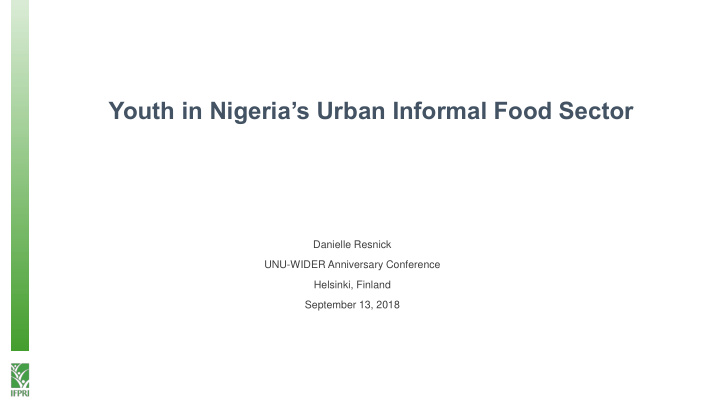



Youth in Nigeria’s Urban Informal Food Sector Danielle Resnick UNU-WIDER Anniversary Conference Helsinki, Finland September 13, 2018
Why urban informal food trade? ▪ Major concern about lack of high productivity jobs for the youth in Africa ▪ Youth are 40% more likely to migrate to urban areas, especially due to life cycle effects (WB 2006) ▪ Informal economy constitutes approximately 70% of non-ag employment in urban Africa (ILO 2018) ▪ Informal food retail is one of the largest segments of the informal economy
Why Nigeria? ▪ Urban youth employment massive challenge given growing population levels ▪ Of those in informal sector, 41 percent in retail trade (LFS 2016) ▪ Supermarkets constitute only one- third of Nigeria’s food retail sales while informal food markets are the major source (Nzeka 2011) ▪ State governments often have a volatile relationship with vendors o Abuja, Enugu, Lagos, and Kaduna have harsh policies on street trading o Repeated demolitions of stalls in markets of Niger state o But, Hawkers’ Rights Bill in Cross River State
Methodology ▪ Surveyed 1,100 traders in two of Nigeria’s “secondary” cities (Calabar and Minna) o Variation in terms of social/ethnic composition, political strongholds, and regulatory setting for traders ▪ Stratified between those located in markets and those trading on pavements/streets ▪ Focused on traders of three types of goods: fresh foods, prepared foods, and packaged foods
Are traders disproportionately young? ▪ One-third of 25-34 year olds are traders Age Distribution of Traders ▪ 70% of young traders are women in 40 Calabar but only 23% in Minna 35 30 Percentage 25 ▪ Approximately half are migrants in 20 Calabar, with most coming from a 15 neighboring state 10 5 ▪ Less than a quarter of youth are 0 migrants in Minna 18-24 25-34 35-44 45-54 55+ 18-24 25-34 35-44 45-54 55+ Calabar Minna
Is trading a stepping stone or the status quo? Education by Age Distribution in Nigeria ▪ Almost 80 percent of youth had at least 100.0 one parent who also was a trader 80.0 60.0 40.0 20.0 ▪ Relatively well educated compared to 0.0 18-24 25-34 35-44 45-54 55+ older counterparts, especially in Calabar No school Some primary Primary completed Some secondary Secondary completed Post-secondary qualification Share looking for another job ▪ Most have been trading between 1 to 5 60.0 years, with about 30 percent between 6 50.0 to 10 years in Calabar 40.0 30.0 20.0 10.0 0.0 18-24 25-34 18-24 25-34 Calabar Minna
Are young traders disproportionately vulnerable? ▪ Youth are significantly more likely than older traders to operate as iterant hawkers in Calabar than in Minna ▪ In both cities, youth significantly less likely to own their market stall ▪ No significant difference in terms of earnings per day or customers, compared with older traders ▪ Youth in Calabar experience higher levels of government harassment than counterparts in Minna
Are young traders disproportionately mobilized? ▪ Youth in Minna significantly more likely to participate in protest or attend political rally than older counterparts ▪ Levels of participation are similar with youth in Calabar but no age specific differentiation ▪ Relatively low levels of associational engagement in informal sector unions
Conclusions ▪ From looking at informal traders, employment in Nigeria appears to be more of a structural change issue than a youth challenge ▪ Many young traders are following a family tradition, rather than switching from agriculture to trade o True even among those who migrated ▪ Variation emphasizes need for nuanced policy responses, not just across different youth groups but even sub-nationally ▪ Governments rhetorically committed to supporting youth but draconian policies towards the informal economy are detrimental to the youth, with important gender implications
Recommend
More recommend